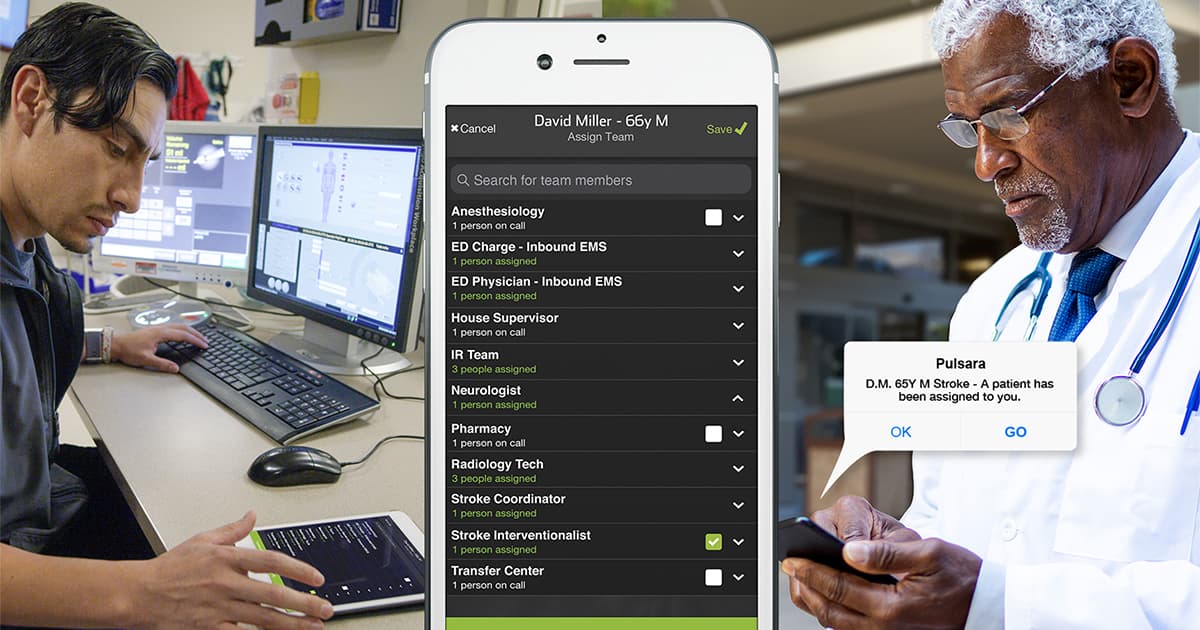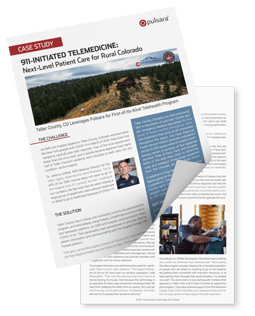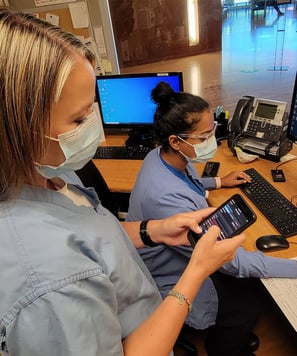Pulsara Around the World - 2025 Recap and January 2026
December Recap After an incredibly busy events year with 102 conferences, trade shows, and sponsorships, December was on the slower side for us, with...
6 min read
 Team Pulsara
:
Dec 20, 2021
Team Pulsara
:
Dec 20, 2021

It has been a challenging year in healthcare. The second year of the COVID-19 pandemic has brought burnout, staffing shortages, and the continued struggles associated with trying to care for patients during a pandemic.
In the midst of it all, many healthcare systems have risen to the challenge and devoted themselves to providing better, faster, and more efficient care for their patients. They've achieved amazing things in 2021, and, in spite of the setbacks and challenges, have found ways to continue to deliver top-notch care for their patients.
Join us as we take a walk through Pulsara's 2021 case studies, celebrate the stories of some of our partner organizations, and highlight the amazing results they've achieved this year!
When the COVID-19 pandemic flared in the state of Texas in early 2020, the state struggled to load balance their COVID-19 patients. Some areas of the state experienced overwhelming waves of surge, while other areas had available beds and resources. Matching the particular needs of complex patients with available beds and other resources necessary for each patient was difficult.
The Texas Emergency Medical Task Force (TX EMTF) through the State Coordination Center (SCC) sought out a solution that would help create a virtual placement center for smooth patient transfers—supporting effective COVID-19 management and surge mitigation and a 75% reduction in excessive phone calls.
Using Pulsara, Regional Medical Operation Coordinating Centers (RMOCCs) in areas under surge were able to create and post a list of patients needing a transfer, as well as their condition and specific needs. Facilities and MOCCs across the state could access this list and seamlessly coordinate transfers for patients, avoiding miscommunication and efficiently connecting patients with the help they needed. RMOCCs in Texas leveraged Pulsara to create a statewide virtual system where hospitals could see and select patients that they had the ability to help.
Download the Texas EMTF case study here
 As EMS and hospital leaders in Teller County, Colorado watched cities like New York grapple with COVID-19 in March of 2020, they knew they needed to carefully plan their response. Fear of the virus spread even faster than the virus itself, and it quickly became apparent that nearly half of Teller County’s residents were reluctant to seek care—for any condition—at the hospital. Dr. Jeremy DeWall, EMS Medical Director for the Teller region, observed the trend firsthand. “Up to 40% of our EMS volume does not want to go to the hospital once 911 arrives,” he said. “Looking at our numbers, the fear was that we were missing a large group of people who were without healthcare or afraid to go to healthcare because of COVID-19.”
As EMS and hospital leaders in Teller County, Colorado watched cities like New York grapple with COVID-19 in March of 2020, they knew they needed to carefully plan their response. Fear of the virus spread even faster than the virus itself, and it quickly became apparent that nearly half of Teller County’s residents were reluctant to seek care—for any condition—at the hospital. Dr. Jeremy DeWall, EMS Medical Director for the Teller region, observed the trend firsthand. “Up to 40% of our EMS volume does not want to go to the hospital once 911 arrives,” he said. “Looking at our numbers, the fear was that we were missing a large group of people who were without healthcare or afraid to go to healthcare because of COVID-19.”
Teller County has a robust and successful community paramedicine program and was already using Pulsara for EMS and hospital communication when COVID-19 hit. Their paramedics were accustomed to securely sharing patient information and communicating with the hospital through the Pulsara platform.
That gave James McLaughlin, Director of Community Paramedicine at Ute Pass Regional Health Service District, an idea. McLaughlin joined forces with Dr. DeWall and Emergency Medical Specialists, PC to set in motion a 911-initiated telemedicine program, allowing community paramedics to continue to serve patients and get them examined by a board-certified emergency physician—from their homes. UPRHSD and EMS, PC worked together to continue to care for patients through the COVID-19 pandemic, reaching underserved populations and providing their community with a personalized, high-quality level of care.
Read the Teller County case study here

As a two-hospital healthcare system with a freestanding emergency department and Level III Trauma Center, EvergreenHealth in Kirkland, Washington serves a population of nearly 850,000 residents. Over the past few years, their teams and service lines have grown accordingly.
EvergreenHealth’s stroke teams were using pagers and audio calls to coordinate care. However, as both the hospitals and the stroke program grew, they began straining the limits of what former standard technologies could support. To optimize communication within their growing system, EvergreenHealth chose to implement a communication and telehealth solution that could scale with them: Pulsara.
In the summer of 2020, EvergreenHealth achieved a record low door-to-puncture time of 78 minutes with Pulsara. By the summer of 2021, they hit a new record low: 46 minutes. Within one year, EvergreenHealth decreased their record door-to-puncture by an additional 41%.
Download the EvergreenHealth case study here
As a tertiary care center and Level I trauma facility in Colorado Springs, Colorado, the trauma team at UCHealth Memorial Hospital Central had their patient care process dialed in. However, there was one part of their process they weren’t satisfied with: their communication system.
Even though delays only lasted a few minutes, they took up valuable time that the trauma team needed to prepare for incoming patients. Very little information about the patient was transmitted ahead of time, which made it difficult for the team to mobilize the correct resources before the patient’s arrival. And as with most paging systems, it was impossible for the charge nurse on duty to tell whether team members had received and seen their notifications.
After implementing the Pulsara platform and working to streamline their processes, UCHealth’s trauma team now sends and receives faster notifications, complete with more detailed patient information. The trauma team has been receiving notifications about incoming patients 5-7 minutes faster, which makes a big difference in their ability to prepare. Communication has also improved with specialty teams. Previously, it took trauma surgeons 7.97 minutes to reach the bedside for a full trauma. In the 6 months after implementing Pulsara, that number dropped to 2.18 minutes—a 73% decrease. For patients experiencing both a stroke and trauma (strauma), UCHealth’s average door-to-CT time was 22.3 minutes. Their new average is 13.5 minutes—a 39% decrease.
Download the UCHealth case study here
Saline Memorial Hospital serves a rapidly growing population of 120,000 in the rural area of Saline County, Arkansas. With a rapidly growing population and a system running to keep up, Saline Memorial Hospital was looking for a way to reduce their treatment times for patients arriving via EMS. And because it serves a dispersed population across a large service area and is the only American College of Cardiology Accredited Chest Pain Center in the community, Saline Memorial struggled to keep first medical contact-to-device times low.
In late 2020, Saline Memorial partnered with Pulsara to decrease their first medical contact-to-device time. Their times dropped from 105 minutes in December of 2020 to 75 minutes in March of 2021—a 28% decrease over four months, and a full 15 minutes under the ACC and AHA recommendations.
Download the Saline Memorial case study here
Ouachita County Medical Center (OCMC) is a not-for-profit hospital serving the rural community surrounding the city of Camden in southern Arkansas. As a smaller, non-PCI facility, OCMC often coordinates transfers for their STEMI patients to PCI facilities.
Seeking a way to dramatically, quickly, and cost-effectively improve door-in, door-out (DIDO) times across the state of Arkansas, the Department of Health launched a pilot program to implement Pulsara. After implementing the Pulsara platform in early 2018, OCMC's average DIDO time for STEMI patients quickly dropped from 72 to 41 minutes—a 43 percent decrease. Halfway through 2021, that number continued to decrease to 36 minutes, despite the impact of the COVID-19 pandemic. Within three years on the platform, OCMC cut their DIDO by 50 percent. That’s nearly 4 times less than the average 140-minute DIDO time when transferring to another of their frequent referral hospitals.
Check out the Ouachita County Medical Center case study here
What if you could keep hundreds of low-acuity patients a week from having to needlessly go to the emergency room? And what if, by doing so, you could reduce or eliminate the challenge of slow turnaround times, free up much-needed EMS and hospital resources, and help patients get the care they need faster, more affordably, and more efficiently?
In August of 2021, Austin-Travis County EMS switched gears with their elite C4 unit to begin focusing on low-acuity patients. Using Pulsara to create a scalable system of care that they could use to pull in other facilities and community resources, they kept 434 low-acuity patients out of the hospital in just three weeks—rerouting them to faster and more appropriate care via the interconnected support of their clinic partner agency and the telehealth communications and logistics platform Pulsara.
While a case study will be forthcoming in early 2022, we didn't want to wait to share with you the groundbreaking work that Austin-Travis County EMS and their partners at WellMed have been doing over the past few months. Commander Steve White and Dr. Carlos Navarro recently hosted a webinar to talk about their program and the success they've seen so far!
Check out the webinar and interview transcript here
In spite of all the challenges that have come with 2021, this year saw an unprecedented amount of innovation and grit among healthcare workers. It's our privilege to walk alongside you as you make strides in patient care and strive to serve your patients with everything you have. Thank you for all your hard work, your sacrifices, and your devotion to excellence in patient care!
To learn more about how hospitals and EMS organizations are using Pulsara, check out our customer success stories. Pulsara is also helping with COVID-19 management by helping mitigate patient surge, streamlining patient transfers, minimizing exposure, and more. Learn more about COVID-19 + Pulsara here.

December Recap After an incredibly busy events year with 102 conferences, trade shows, and sponsorships, December was on the slower side for us, with...

Editor's Note: In July 2025, EMS1 and Fitch & Associates released their annual EMS trend survey, What Paramedics Want, proudly sponsored by Pulsara....
![[PRESS RELEASE] Published Research Finds Up to 31% Faster STEMI Treatment Times in Rural Hospital Setting with Pulsara](https://www.pulsara.com/hubfs/_1_website-page-blog-assets/pulsara-hosp-teams-assign-cardio-stemi-rn-1200x701.jpg)
Published research shows how using Pulsara, alongside standardized field activation and a focus on stakeholder relationships, improves STEMI care and...